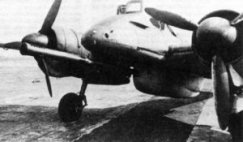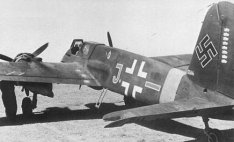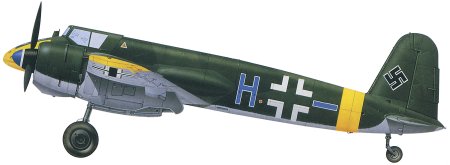
Henschel Hs 129
In 1937, the Technische Amt issued a specification for a cannon-armed close-support aircraft, small in size but heavily armoured. The final competing aircraft were the Focke-Wulf Fw 189 and the Hs 129. Both aircraft performed particularly badly in test, showing sluggish performance and the Hs 129's cramped cockpit was unpopular.
The Hs 129 eventually won, not because it was superior but because it cost about two-thirds as much as the other type and was smaller. Eight pre-production Hs 129A-0s with Argus As 410A-1 engines were tested, but it soon became obvious that the aircraft was under-powered. Henschel's chief engineer set about designing a new larger vision with Gnome-Rhone engines.
The resulting Hs 129B was a great improvement. The cockpit was modified with larger areas of armoured glass, giving better vision and superior protection.
After the invasion of the Soviet Union in June 1941, it became obvious that the Hs 129B would be an essential weapon, but poor engine reliability and production problems lowered confidence in the aircraft. When introduced to North Africa in 1942 the first Hs 129 unit suffered engine problems caused by sand ingestion and was evacuated with no serviceable aircraft.
Various improvements incorporated into the Hs 129B-2 finally resulted in some success against Soviet armour, but by the Spring of 1945 few remained in service.
Designed in 1938, the Hs 129 was the only aircraft of World War II to be designed from the outset explicitly for destroying hostile armour. Its angular shape and small cross-section made the aircraft look aggressive and its powerful cannon could penetrate any tank's armour. However, the type suffered from a protracted developement and the problems of lack of power and unreliability from its twin engines were never fully resolved.
 |
 |
 |
| Arriving in North Africa at the end of 1942, the Hs 129B encountered serious reliability problems. |
To provide a hard-hitting weapon for use against Soviet tanks, the Hs 129B-3/Wa was developed with a 75 mm Pak 40 gun. |
Captured in North Africa, this Hs 129B was flown to the United States for evaluation. It carries the 'Foreign Equipment' registration FE-4600. |
|
Henschel Hs 129 (Technical Specification) |
| Role |
Single-seat close-support and anti-tank aircraft |
| Manufacturer |
Henschel |
| Maximum Speed |
407 kmh (252 mph) |
| Maximum range |
688 km (425 miles) |
| Ceiling |
9,000 meters (29,500 feet) |
Weight
Empty
Maximum Takeoff |
3,810 kg (8,382 lbs)
5,250 kg (11,550 lbs) |
Dimensions
Wingspan
Length
Height
Wing Area |
14.20 meters (46 ft 7 in)
9.75 meters (13 ft 1 in)
3.25 meters (10 ft 8 in)
29.00 square meters (312 sq ft) |
| Engines |
Two Gnome Rhone 14M 4/5 14-cylinder air-cooled radial air-cooled piston engines which provides 522-kW (700-hp) |
| Armament |
Two 7.9 mm (0.31 in) MG 17 machine guns
Two 20 mm (0.79 in) MG 151 cannon in nose
Four 50 kg (110 lbs) bombs
92 2 kgs (4 lbs) anti-personnel bombs
One 250 kgs (550 lbs) bomb beneath the fuselage
Two 50 kg (110 lbs) bombs
48 2 kgs (4 lbs) anti-personnel bombs on wing racks |
Photo Gallery
Click here to submit your photo
| Have A Passion For Aircraft? |
Subscribe to our 14 series FREE newsletter
delivered weekly on World War 2 Aircraft factfile... |
| NB:- We hate spam as much as you do, so your email address will NEVER be shared with or sold to anyone else. That's a Guarantee. |
|
|





